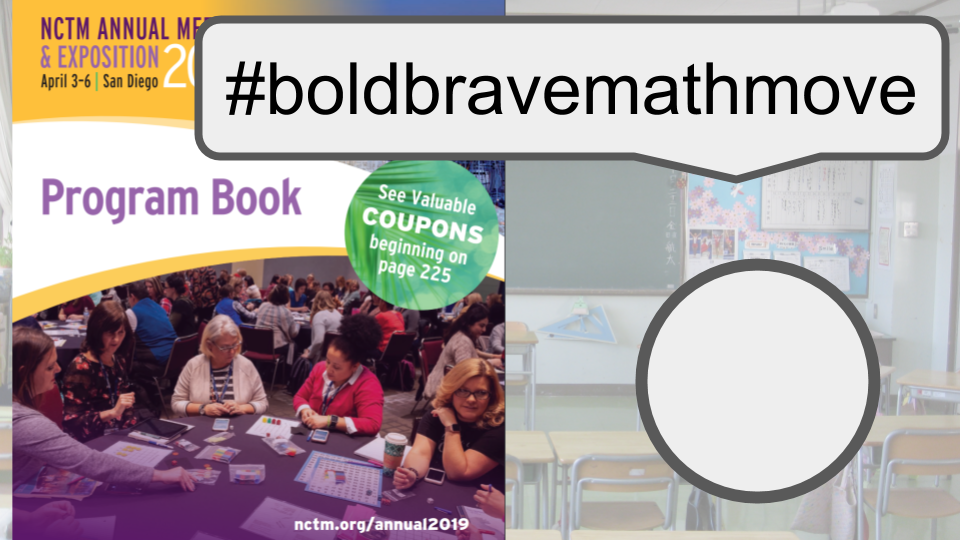Thanks to everyone who came to my session today. We came up with a lot of ideas for projects and thought even more about how to actually teach them in your classroom. It was a great session and one that I’ll continue to think about and would love to talk about more in the comments or on twitter.
One of the questions that came out centered around the teacher, and the dual responsibility they have to 1) teach objective, unbiased information so as not to indoctrinate children and 2) prepare them for the actual world. Because the world is full of so much information, teachers need to select and choose and this selcting and choosing can be viewed as subjective. How do you decide whether something you are doing is subjective or objective?
Let’s say you want to teach a unit about public health in your stats unit during 7th grade. Some students may feel like public health issues should not be covered in math class, and the mention rankles their political beliefs while others believe these issues are too important to ignore and whose enthusiasm for change can push them to cherry pick data that supports their beliefs. If you’re that teacher you have quite a choice. As you plan the unit you may try your best to satisfy both students in what they will explore, but ultimately how decide whether it is safe to do or not? In the session we talked about walking the line between objectivity and subjectivity, and choosing whether to use the public health project. I answered the question, but it probably needs some elaboration. Here’s what @justinaion tweeted:
I swear this DJ reference makes sense. When I was a kid I loved DJ’d music, especially house music. My older brother Ray was in College when I was an 8th grader and he would bring down actual cassette mix tapes from actual DJs. I loved them, I played them into the ground and I still hum sections from those tapes from time to time. (Side note: Why do people call them ‘mix tapes’ if the songs play from start to finish without a dj making transitions. Isn’t that just called a ‘tape’? I digress.)
When I got out of college I thought I would try to teach my self to DJ like the tapes that I remembered from the 90s. With a computer I tried to capture the spirit of DJing house music without all of the physical labor required back then, and I got pretty good. I’ll rarely be prouder than when I mixed two songs together exactly like I heard it on an old mix tape after practicing non stop over a February break. My mixes weren’t as important as the fact that it was something I figured out thinking it was impossible for most of my life. I was just good enough to get paid, but ultimately couldn’t be as dedicated as the professionals who I respected and emulated. I decided to pour my energy into my actual job and my kids instead, but I often think about Djing. Especially when I think about things that are hard but I can do it if I just keep trying. I was thinking about DJing when I was getting ready for my talks that morning actually, so it makes sense that it came to mind during that session. Let me be more specific about the exact memory that came to mind.
I had offered my services as a DJ at a charity auction and someone won. I had to bring speakers and my equipment, but they told me I could play whatever I wanted. I convinced my girlfriend that accompanying me to this thing would be more fun than a typical night of board games and netflix with the ruse that I needed help carrying everything. Really I wanted a little boost of confidence. I was 100% confident these people weren’t expecting the house music I was going to play and I wondered whether they would hate it and tell me to pack up and go home early.
An hour into what would be my first, and only, house party gig where this guy came up to me who we can call Chaz. “Hey you should play this song next, I’ll totally get everybody dancing.” I saw that he knew the host of the party, and perhaps he would have more luck with getting people dancing, so I let him plug up his phone. This was nice at first because I could take a break and chat with my girlfriend who helped me lug all the stuff up there. Chaz starts playing music fresh off the radio that everybody is familiar with but no one really likes. After a while I ran out stuff to talk about with my girlfriend and found myself staring patiently at Chaz. “I’m the one that stayed up all night making this house mix playlist,” I thought to myself, “complete with transitions, rises, falls, and crescendos. I lugged all this crap here. This is my first chance to see if I can get people into this house music…” Chaz’s buddy brings him a fresh beer. “I should put my skills to the test and see if I can make this work. I should at least see if it will connect with people.” Chaz dances a little. He’s the only one dancing a little. I turned to my girlfriend and said “Dude has played enough of this garbage. If I’m the supposed to be the DJ, shouldn’t I just go put my songs on.” She looked at me like we were playing a board game and I spaced out and forget that it’s my turn. I told Chaz that I’m taking over after this song. “Ok cool I’ll go to the bathroom and get back on?” “No, I’m taking over for the rest of the night.” I jumped back into my playlist and tried my hardest to get this apartment party to vibe with this music that meant so much to me. Of course, no one danced the rest of the night, but in all reality no one was dancing when Chaz was on the decks either. They gave me a tip at the end, so I think that means they certainly saw some value in it, which gave me the confidence to keep doing it (just not at apartment parties).
There are some parallels between this and the question of objectivity vs. subjectivity.
The objective things are rarely objective, as our society is full of so many flaws and so much bias. To prepare teach kids to eventually inherit this world, they need to practice working on situations that might be subjective and making sense. Luckily math is the tool for making sense of things. Why not sharpen their ability with that tool by using it in situations where it is actually needed. If those two students are working on the health project, and they have criticisms, they should be able to use math to form their arguments. You could even plan for this kind of discord and ask students to present these math-backed arguments to someone else who decide whether something is subjective or not. If all of this or none of this happens, it’s probably better than the “objective” option. It’s better than Chaz playing songs off his phone.
If you’re choosing between taking the risk to do something new in your class instead of a more “objective” option, the first step is to put in the work. Do your best to learn pick a topic and a sequence of opportunities that are going to deliver the math objectives. Learn from the resources attached at the bottom of the google doc. Talk to other teachers, and people in your school to get feedback. Look for a low stakes place to put it into your scope and sequence. Make sure to actually be prepared to DJ with your set list and your backup songs. Don’t show up trying to play stuff off your phone.
Lastly, when it’s time to put your song on, put your song on. Do the activity, it’s ok if it doesn’t go well, it will go better next time. The important part is to try it, since anything is better than what I imagine would be in the textbook or whatever. When you don’t try it out, you miss out on the opportunity to get better at working with these kinds of tasks and the kids miss out too. The longer you wait, the longer Chaz will keep playing that garbage. Chaz has played enough of that garbage. You’re the DJ. Go put your song on.





